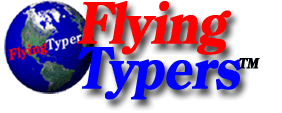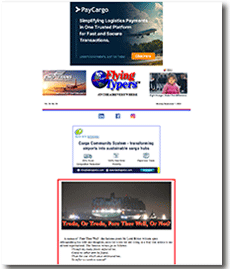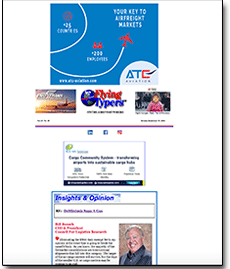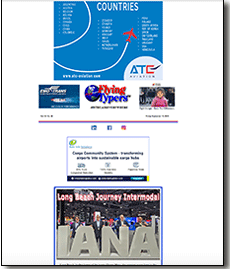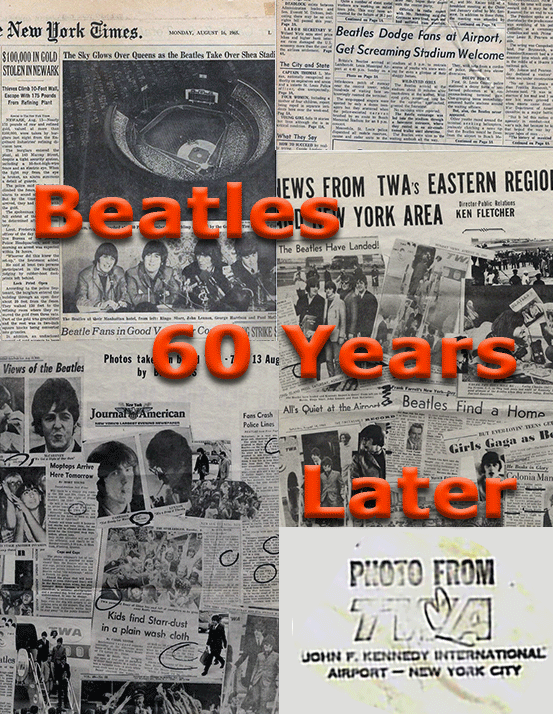 |
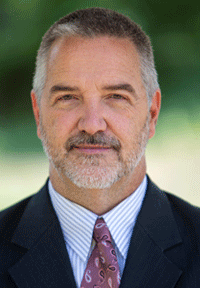 As long as we have known him Michael Webber, when he is not planning airports, is talking about music. As long as we have known him Michael Webber, when he is not planning airports, is talking about music.
It just so happens that both of us believe that music is an essential part of life, like breathing out and breathing in.
Mike was brought up in the great jazz atmosphere of Kansas City, USA and later studied at Tulane University in New Orleans, where he was just a stone’s throw away from Bourbon Street, the jazz capital of the world.
Little wonder that in 2015, when Mike suggested he share his take about the day 50 years prior on August 15,1965 when The Beatles visited John F. Kennedy International Airport, we said yes.
We had covered that story in pictures in two of our Great Airports History books.
Mike went very deep dish into the story and also created a second chapter of The Beatles USA odyssey for our readers when the group returned to USA and visited the West Coast.
In the second story Mike shared more fascinating cabin crew insights and experiences he had meticulously gathered over the years.
Well here we are in fall 2025, 60 years later, and luckily here also is Mike closing the circle with Part Three of what has become a Beatles Trilogy, this one including music and logistics and other memories.
So in case you want to connect: Climb onboard Part One and Part Two created a decade ago as they appeared in FlyingTypers.
Just for you, our airport-based magical memories tour takes off once again.
Hope you enjoy the ride.
Geoffrey Arend
Prologue: Place They'd Remember
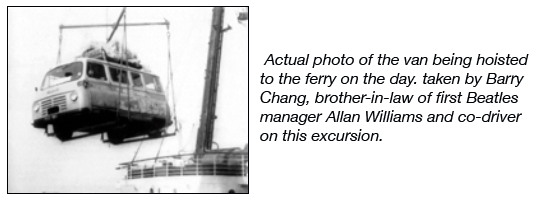 |
In the morning of August 15, 1960, a marginally popular local band, their booking agent and his brother-in-law finished loading musical equipment and scant personal belongings into an Austin J4 minibus. The Beatles were leaving Liverpool on their first trip to Hamburg – trading one rough port city for another. Both port cities were freight hubs that were bombing targets in wartime and cultural gateways in peacetime due to the circulation of people and cargo from around the globe.
The van arrived at the quay in Harwich on England’s eastern coast to be lifted by crane onto a ferry to the Hook of Holland where the road trip resumed. The entourage finally arrived in Hamburg’s Reeperbahn redlight district in the evening of 8/16/60. John Lennon was 19 years old, Beatle George Harrison was only 17 and Paul McCartney was born between the two. Ringo Starr was still nearly two years from becoming a Beatle.
A club owner alarmed at the prospect of losing the band to a rival club reported Harrison to German authorities for being underage to enter the clubs in which he’d already been playing for three months. With a deportation order in hand, Harrison was dropped alone at a local station to begin the solo train trip back to the ferry from Holland to Harwich. Back on English soil, Harrison boarded another train to London’s Liverpool train station, from which he took a taxi to London’s Euston station to board yet another train to Liverpool’s Lime Street Station. With barely a pound sterling to spare, the kid navigated multiple transfers between cabs, trains and ferries in three different countries using only analog guides.
Accused by the same club owner who reported Harrison, Paul McCartney and (pre-Ringo) Beatles drummer Pete Best were also deported but this time for suspicion of attempted arson. With Harrison of legal age and a contract for another Hamburg residency the following year, McCartney and Best reimbursed the West German government for the airfares of their previous deportation flights before being allowed to re-enter the country.
Between residencies in Hamburg and Liverpool, The Beatles clocked thousands of hours on club stages. The contract for their 1961 residency in Hamburg required The Beatles to play 104 consecutive nights with weekday performances running 4.5 hours and weekend shows extending to 6 hours. Between February 1961 and August 1963, the band played 274 gigs at Liverpool’s Cavern Club, alone.
A Little Help From Friends
In 1961, 19 year-old Neil Aspinall became the Beatles’ driver/road manager. His basic qualification was simply that he was a friend of Best’s and was willing to lease-purchase a used Commer van (£80 at the time). To service his debt, the former accounting trainee charged each Beatle five shillings (25p) per person, per concert.
In January 1962, The Beatles signed a management contract with 27-year-old Brian Epstein who had no experience managing artists but had managed the record department of his parents’ department store. Theater-trained Epstein put the band in matching suits, and forbade their eating and swearing on-stage. Motorhead’s legendary bassist, the late Lemmy Kilmister, more colorfully put it: “The Beatles were hard men. Brian Epstein cleaned them up for mass consumption, but they were anything but sissies. They were from Liverpool, which is like Hamburg or Norfolk, Virginia – a hard, sea-farin' town, all these dockers and sailors around all the time who would beat the piss out of you if you so much as winked at them. Ringo's from the Dingle, which is like the fucking Bronx.” (quoted from the autobiography White Line Fever, by Lemmy Kilmister, 2004.)
At the others’ request, Epstein fired Pete Best in favor of Ringo Starr and within the year, Epstein secured a recording contract – their holy grail.
Their first single “Love Me Do” debuted on October 5, 1962, peaking at #17. With a record in the UK charts, The Beatles had become a national act.
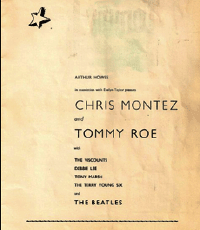 A coach (bus) tour of England began in early 1963 with The Beatles at the bottom of a six-act bill headlined by 16-year-old Helen Shapiro. Compared with hours-long sets they had been playing, The Beatles’ sets as openers were as little as 12-minutes. Even with daily matinee and evening shows, the band took additional gigs for up to 4 individual performances per day. In his van, Aspinall followed the tour bus to transport the band to an additional one or two nearby clubs on the same day. A coach (bus) tour of England began in early 1963 with The Beatles at the bottom of a six-act bill headlined by 16-year-old Helen Shapiro. Compared with hours-long sets they had been playing, The Beatles’ sets as openers were as little as 12-minutes. Even with daily matinee and evening shows, the band took additional gigs for up to 4 individual performances per day. In his van, Aspinall followed the tour bus to transport the band to an additional one or two nearby clubs on the same day.
In 1963, The Beatles improved their UK chart performance with “Please Please Me” reaching #2 and then topped the charts with “From Me to You”, “She Loves You” and “I Want to Hold Your Hand”. Tours supporting Americans Chris Montez and Tommy Roe had already been booked. UK audiences customarily honored visiting American rockers as the “authentic” article 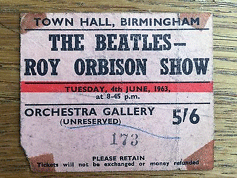 but the response to The Beatles increasingly challenged the headliners. Eventually, their American hero Roy Orbison elected to switch slots so The Beatles could headline, rather than defy the obvious will of their increasingly loud, shrieking fans. but the response to The Beatles increasingly challenged the headliners. Eventually, their American hero Roy Orbison elected to switch slots so The Beatles could headline, rather than defy the obvious will of their increasingly loud, shrieking fans.
Contrasted with the years toiling in clubs as a local act, their period of supporting slots on national tours was relatively brief but critical. The fan phenomenon, Beatlemania had been born and simply getting the band into and extracting them from venues was no longer a one-man job. Aspinall was promoted to personal assistant and Mal Evans (a former Cavern bouncer) was hired in August 1963 to be their roadie.
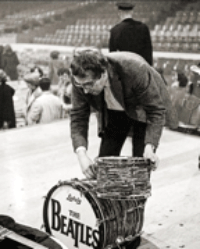 The Beatles’ core that would tour the world for the next three years was this decidedly provincial collective: four Beatles with only McCartney having graduated from high school; manager Epstein, Aspinall and Evans (pictured left). The Beatles’ core that would tour the world for the next three years was this decidedly provincial collective: four Beatles with only McCartney having graduated from high school; manager Epstein, Aspinall and Evans (pictured left).
North America, continental Europe, Australia and Asia awaited. Epstein underestimated how touring America differed from touring England’s 2-3,000 seat theaters. In addition to absorbing the punishing travel demands of a country the size of a continent, The Beatles would be betrayed by the audio limitations in America’s larger arenas and stadiums.
New York-based entertainment lawyer, the late Nat Weiss (1927-2013) was Epstein’s “man in America”. With decades of experience, Weiss provided context for Epstein’s challenges to simultaneously navigate a foreign market and an unprecedented phenomenon. “When Brian (Epstein) came to America, there were no groups that could fill stadiums. There were no groups that could fill Madison Square Garden. We had Elvis, in a limited sense, but Brian, he created a lot of these things. The idea of putting together a tour of stadiums, and large arenas, and organizing all of these things, was new,” Nat Weiss said.
Previous installments of this series already detailed the Beatles’ arrival at JFK for the February 1964 Ed Sullivan shows, as well as their return trip arriving at LAX for their first full-fledged North American tour in Fall 1964.
Five years to the day since their maiden departure for Hamburg, The Beatles began their second U.S. tour on August 15, 1965, at New York’s Shea Stadium.
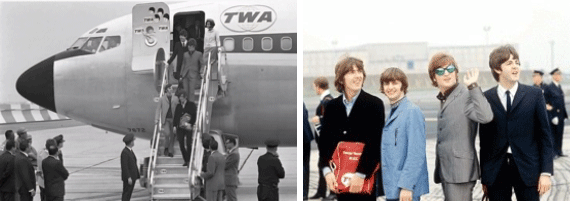 |
The Beatles arrived again at JFK International Airport but deplaned far from the public. Contrasted with Pan Am the previous year, TWA’s promotion comprised only Beatle mop tops painted inside the boarding door, as well as TWA tote bags personalized for each Beatle.
With a paid audience of 55,600, Shea was a commercial triumph that Lennon later described as their “mountaintop”. The concert was filmed for later broadcast in the UK but the band’s inability to hear one another required re-recording several performances in the studio to be suitable for broadcast. The album version of Ringo’s feature song “Act Naturally” was wholly substituted with dubbed applause for effect. Sat on a riser behind the other three, on-stage sound quality was so inadequate that Ringo kept time (rhythm) by watching the bodies of the three Beatles positioned just a few feet in front of him.
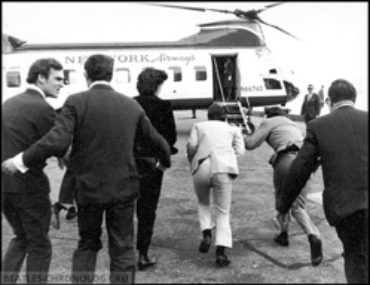 A proposed helicopter landing on the playing field was vetoed by local authorities for safety reasons. Instead, the band was transported by limousine from the Warwick Hotel to a waterfront heliport where they boarded a New York Airways’ Boeing Vertol 107-II helicopter to the roof of the World’s Fair building in Queens. For the final mile into Shea, they were loaded into a Wells Fargo armored car. At first, these maneuvers may have seemed exciting but on repeat, the novelty would give way to claustrophobia. A proposed helicopter landing on the playing field was vetoed by local authorities for safety reasons. Instead, the band was transported by limousine from the Warwick Hotel to a waterfront heliport where they boarded a New York Airways’ Boeing Vertol 107-II helicopter to the roof of the World’s Fair building in Queens. For the final mile into Shea, they were loaded into a Wells Fargo armored car. At first, these maneuvers may have seemed exciting but on repeat, the novelty would give way to claustrophobia.
From New York, the tour continued aboard North American flights operated by Fort Worth-based charter airline American Flyers Airline (AFA). Reprising their role from the 1964 tour, AFA operated two Lockheed 188C Electras with a Lockheed Constellation as a spare. Aircraft and crews were rotated to manage on-duty service limitations.
An August 19, 1965, arrival at Houston Hobby Airport nearly turned nightmarish. Even at 2:00 in the morning, approximately 5,000 fans waited to greet the arriving Beatles. Interviewed in 2004 for a cover story in Airliners, Chief Pilot John Harrington recalled: “When the plane taxied in, the crowd broke through the police blockade and ran toward the Electra. I thought I was about to witness the unimaginable. Those kids were obviously unaware of the props still rotating as the airplane taxied. Fortunately, the captain saw what happened and shut down the engines in time. After the police lost control of the crowd, we could not move the airplane. It was completely surrounded with fans banging on the fuselage. We managed to get a catering high-lift truck to the rear cabin door, and the Beatles jumped in. It took forever for that truck to get a clear path out of the area.
Tomorrow Never Knows: The Final Tour And Studio Years
Financial rewards notwithstanding, The Beatles’ final year of touring in 1966 was even more stressful. Their 1966 tour of Asia began with riots in Tokyo due to disapproval over Western music being performed at Nippon Budokan where only traditional events had been held.
The next stop in the Philippines turned violent when a perceived snubbing of President and First Lady Marcos led to The Beatles’ security detail being terminated. The Beatles’ entourage was subjected to physical attacks by mobs of Marcos supporters at Manila Airport’s departure areas. Epstein, Evans and Beatles chauffeur Alf Bicknell were injured. Bicknell suffered a fractured rib and spinal injury. Evans was tackled and kicked repeatedly.
Returning to London Heathrow, a weary George Harrison answered a reporter about upcoming live shows: “we’re going to have a couple of weeks to recuperate before we go and get beaten up by the Americans.”
A Lennon comment about the state of Christianity created a backlash in parts of the U.S. Both the Ku Klux Klan and John Birch Society were eager to exploit any opportunity to elevate their own profiles and to punish artists who had insisted on integrating U.S. venues and consistently toured with Black opening acts. Albums and memorabilia were thrown on bonfires arranged by religious demagogues. Death threats were common. The Klan even marched outside the concert in Memphis about two years before Martin Luther King Jr. was assassinated in that city. Cherry bombs thrown from the audience during The Beatles performance momentarily had the band wondering if a shot had been fired.
Thousands of hours honing their act in dingy clubs turned The Beatles into formidable live band. Three years of deafening screams overwhelming primitive stadium public address systems transformed them into a live farce. Worse, the grind of touring and incomparable fame shredded their psyches. In interviews for The Beatles Anthology series, Harrison observed “they (the fans) gave their money, and they gave their screams. But the Beatles kind of gave their nervous systems.”
Augmenting the band’s dissatisfaction with touring, the intricacy of their new music was incompatible with the period’s live technology. While they could still reasonably plow through Little Richard’s “Long Tall Sally” for the thousandth time since their club days, attempting the neo-classical “Eleanor Rigby” was out of the question.
Consequently, only one song (“Nowhere Man”) from the UK version of 1965’s Rubber Soul album was ever performed live. Nothing from their Revolver album was attempted for the 1966 tour ostensibly supporting that album’s release. After more than 1,400 individual concerts, The Beatles performed their last scheduled concert on August 29, 1966, at San Francisco’s Candlestick Park. Apart from provisionally live performances in a UK television studio and a final unannounced performance on the rooftop of the London building that housed their company Apple, the live Beatles were through.
Epilogue: Bands On The Run
From 1967’s Sergeant Pepper’s Lonely Hearts Club Band through 1969’s Abbey Road, The Beatles were liberated from even considering whether their new music could be taken on tour. The last time all four Beatles were present in a recording studio was August 20, 1969 – just shy of three years since their final scheduled concert. It had only been nine years since John, Paul and George first left Liverpool for Hamburg. None of the Beatles had even reached 30 years of age.
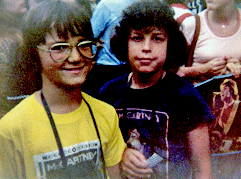 When Paul McCartney returned to America in 1976. The Wings Over America lighting crew, alone, equaled in number The Beatles’ entire crew. Wings had a 4-man horn section, plus individual technical specialists for guitars, keyboards and drums. Nonexistent in 1966, a synthesizer could replicate entire string sections. Modern on-stage monitors enabled musicians to easily hear one another even with McCartney still inducing Beatlemania-level screams. When Paul McCartney returned to America in 1976. The Wings Over America lighting crew, alone, equaled in number The Beatles’ entire crew. Wings had a 4-man horn section, plus individual technical specialists for guitars, keyboards and drums. Nonexistent in 1966, a synthesizer could replicate entire string sections. Modern on-stage monitors enabled musicians to easily hear one another even with McCartney still inducing Beatlemania-level screams.
I know because I was there (12-years-old, in the yellow shirt and glasses) with my elementary school best friend when McCartney brought Wings to Kansas City’s Kemper Arena on May 29, 1976.
Sidebar: Come Together In Jacksonville
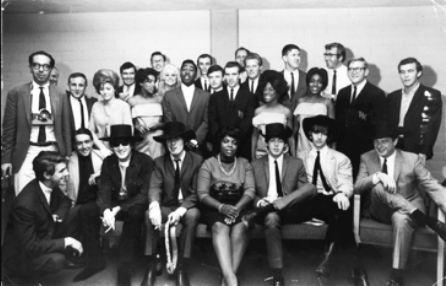 In addition to impacting how artists write, record and perform, The Beatles used their influence to inspire social change. On their first U.S. tour, the band threatened to cancel a performance at Jacksonville’s Gator Bowl upon learning that the upcoming venue would be segregated. Traveling with two Black opening acts – The Exciters of “Tell Him” fame and New Orleans’ Clarence “Frogman” Henry – Lennon unequivocally declared “we never play to segregated audiences and we’re not going to start now.” From then on, The Beatles insisted upon a rider in performance contracts that under no circumstances would they play for segregated audiences. Having integrated the Gator Bowl, the band still elected to fly immediately to Boston rather than stay the night in a Jacksonville hotel where their opening acts would not be welcomed. In addition to impacting how artists write, record and perform, The Beatles used their influence to inspire social change. On their first U.S. tour, the band threatened to cancel a performance at Jacksonville’s Gator Bowl upon learning that the upcoming venue would be segregated. Traveling with two Black opening acts – The Exciters of “Tell Him” fame and New Orleans’ Clarence “Frogman” Henry – Lennon unequivocally declared “we never play to segregated audiences and we’re not going to start now.” From then on, The Beatles insisted upon a rider in performance contracts that under no circumstances would they play for segregated audiences. Having integrated the Gator Bowl, the band still elected to fly immediately to Boston rather than stay the night in a Jacksonville hotel where their opening acts would not be welcomed.
No doubt moving all the equipment needed to deliver The Beatles in Concert during the formative years of air cargo, and rock'n roll tours of the early 1960's can be recalled as a pioneering effort and a herculean task.
Today when you think of rock concerts and how all that equipment gets to an event in America or anywhere in the world, think highly specialized logistics all the way.
How big a business is shipping guitars and amps and other related musical concert equipment around the world?
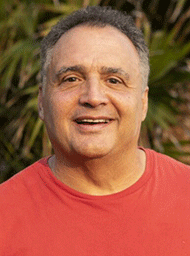 Rock-it Cargo was founded in Los Angeles during 1972 and, by 1978 under the direction of David Charles Bernstein, (left) was moving some of the most popular bands around the world. Rock-it Cargo was founded in Los Angeles during 1972 and, by 1978 under the direction of David Charles Bernstein, (left) was moving some of the most popular bands around the world.
Rock-it Cargo developed itself as a logistics machine moving equipment for artists like Billy Joel and the crew that brought Metallica to Antarctica in 2013, among other historic and important firsts.
Parent company ATL Partners moved Rock-it-Cargo into Global Critical Logistics (GCL) in 2022, when GCL was established as the holding company for the company and its brands.
In May 2025, GCL and its parent company ATL Partners were acquired by Providence Equity Partners LLC (PEP) who became major shareholders.
The Wall Street Journal reported the deal worth $1 billion had ATL retaining a minority equity stake.
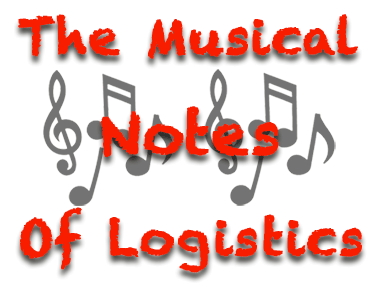 PEP is a global giant that among other properties holds investments in YES Yankees Entertainment and Sports Network, Wasserman and World Triathlon Corporation and Major League Soccer, plus many others. PEP is a global giant that among other properties holds investments in YES Yankees Entertainment and Sports Network, Wasserman and World Triathlon Corporation and Major League Soccer, plus many others.
“Our team lives for being a part of the world’s most impactful events. With decades of on-the-ground experience, we know the timelines and requirements of high-caliber productions, and more importantly – we execute,” Rock-it Cargo declares.
Moving ever upward, Rock-it Cargo recently entered a multi-year partnership as the Official Logistics Provider of the FIFA World Cup 2026 and the new FIFA Club World Cup.
Driving musical concerts to locations worldwide Rock-it Cargo delivered Taylor Swift’s record-breaking “The Eras Tour” in 2024.
Moving forward in 2025 Rock-it Cargo’s global footprint includes 10,000 projects in 115 countries with 3,200 city pairings and 47 years of bespoke end-to-end non-stop logistics experience.
Lest we forget, hands across the water, Rock-it Cargo has also supplied modern day in-concert logistics, for none other than the one and only Paul McCartney.
GDA |
A Few More Perspectives:
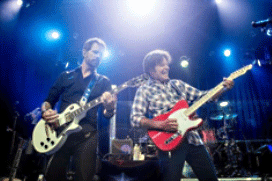 David George is a Kansas City-based musician who has recorded and performed as a solo artist, group member and former sideman for Rock ‘n’ Roll Hall of Famer John Fogerty (Photo to right). David George is a Kansas City-based musician who has recorded and performed as a solo artist, group member and former sideman for Rock ‘n’ Roll Hall of Famer John Fogerty (Photo to right).
“Every band that has hit the road has toured using a van. My band went through three vans. Our first van had so much wear and tear, you could see the road through the rusted-out bottom!
However, I went from a van to a private jet when I played guitar with John Fogerty. We were given anything we needed. I would have a protein smoothie waiting for me the second I got on the plane. As we took the stage, I had a tech handing me my already perfectly tuned guitar. Afterwards, he would hand me a Gatorade and a towel. I would jump in a van and then off to the airport to catch a flight to the next town. We had three-hour rehearsals and a full course meal waiting for us after. The Beatles? Four card-table chairs, and four cokes. Their gear would fit into the back of a station wagon, while ours filled a semi and two tour buses.”
Hear David George and Lukas Nelson (Willie’s son) perform an impromptu version of The Beatles’ Blackbird backstage from the John Fogerty tour.
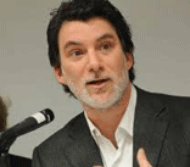 Andy Gershon is a Professor in the Setnor School of Music at Syracuse University where he shares lessons from a career in the music industry. Gershon has discovered and nurtured the careers of The Smashing Pumpkins, Moby and The White Stripes and managed tours for legendary artists including Bryan Ferry of Roxy Music fame. Andy Gershon is a Professor in the Setnor School of Music at Syracuse University where he shares lessons from a career in the music industry. Gershon has discovered and nurtured the careers of The Smashing Pumpkins, Moby and The White Stripes and managed tours for legendary artists including Bryan Ferry of Roxy Music fame.
Given an advanced reading of this article, Gershon observed “touring was so different back then. It is completely unrecognizable to what we have now in the U.S. While the logistics have changed dramatically, the one thing that hasn’t changed from The Beatles at Shea Stadium to Taylor Swift at MetLife Stadium is that there is no substitute for the live experience which is enjoyed as much today as it was then!”
Gershon was nominated for a Grammy Award for Best Compilation Soundtrack Album for the Sean Penn film “I Am Sam” which comprised Beatles songs covered by a surprising roster of contemporary artists, including Aimee Man and Michael Penn’s take on “Two of Us”.
In addition to his impressive studio work as a musician and producer, Brian Kehew has been an instrument technician (principally keyboards) for The Who since 2002 and has performed on keyboards with the band during portions of their 2006-07 tours. Kehew co-authored Recording The Beatles: The Studio Equipment and Techniques Used to Create Their Classic Albums, published in 2006. The book is an indispensable resource for Beatles fans and a triumph of balancing scholarly detail with thoroughly readable prose. Kehew read early edits of this article, providing editorial suggestions, as well as the following:
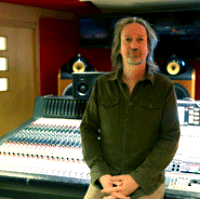 “This is a fascinating article, uncovering many previously unknown facets of The Beatles team on the road. Things were much simpler then, but in a way, so much more difficult. “This is a fascinating article, uncovering many previously unknown facets of The Beatles team on the road. Things were much simpler then, but in a way, so much more difficult.
“Musical tours relied upon the previous ideas and systems of theatrical tours, so it's not wholly uncharted territory, but the scale of it was new here. Yet the backline (stage instruments and amps) remained almost club-level throughout their touring years. It was the sound systems out-front that really lacked in proportion . . . Something really out of the band's control. They did what they could with what they had.
“It's great to see a different angle on their much-explored career. Details like these make the story less like a fairytale and more like hard work amidst a hurricane.”
“In addition to his published works, Kehew has given presentations at Abbey Road Studios’ legendary Studio Two, most recently in August 2024. YouTube has several hours-long interviews with Brian about aspects of recording but here’s a modest (almost 4 minutes) length clip that exhibits his charming mix of technician and fan
Hector Penalosa was the bass player for seminal West Coast Punk band, The Zeros, and currently tours as bassist for The Avengers, as well as fronts his own Hector Penalosa Gang. As part of West Coast Punk Rock’s first wave, he is part of that scene’s royalty.
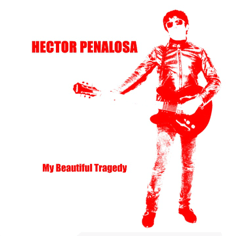 “That first trip to Hamburg was The Beatles’ baptism by fire into playing live for hours on end. Eventually, all those hours on stage made them a musical powerhouse band. They were pretty rough sounding, but energetic and very driven to succeed. All of it while still having fun and with an "ask me if I care attitude ", especially Lennon. “That first trip to Hamburg was The Beatles’ baptism by fire into playing live for hours on end. Eventually, all those hours on stage made them a musical powerhouse band. They were pretty rough sounding, but energetic and very driven to succeed. All of it while still having fun and with an "ask me if I care attitude ", especially Lennon.
“All that raw energy and attitude was also a big part of the Punk Rock ethos. “The Beatles Live! at the Star Club in Hamburg, Germany; 1962.” (a primitively recorded double album of club recordings released in 1977) was basically their Punk album.
“This period is also notable for their metamorphosis from a 5-piece to a 4-piece band. Plus, Ringo Starr occasionally sat in with The Beatles when Pete Best fell ill and we know where that eventually led. I had the honor to play with Best in 2018 at the annual San Diego Beatlefair. The stage manager asked me to play one song with him. We played " Rock n Roll Music", written by Chuck Berry but played by The Beatles in both their club days and stadium shows.”
For many years, Penalosa also anchored a beloved Beatles tribute band – The Baja Bugs - comprising members from the San Diego area and from Tijuana, Mexico. Here they cover early Beatles tune “Little Child.”
“Beatlemania: Touring America on American Flyers Airline” by Vincent Caire, Airliners magazine, September/October 2004 was critically important for the account of the near-disaster at Houston Hobby Airport and for contextual interviews with now-deceased sources.
Renowned Beatles biographer Mark Lewisohn’s 1986 book “The Beatles Live!” was indispensable in confirming dates of concerts and quantifying The Beatles’ on-stage experience. More generally, the scholarly work of researchers and writers like Lewisohn, Brian Kehew and Chip Madinger elevated the standards for anyone even daring to write about The Beatles.
Michael Webber
|

